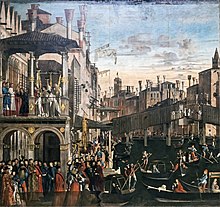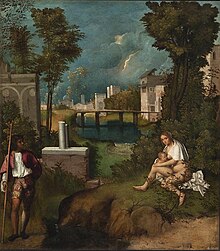



The House of Vendramin (Italian: [vendraˈmin], Venetian: [veŋdɾaˈmiŋ]) was a rich merchant family of Venice, Italy, who were among the case nuove or "new houses" who joined the patrician class when the Libro d'Oro was opened after the battle of Chioggia (June 1380). Andrea Vendramin served as the sole Vendramin Doge from 1476–78, at the height of Venetian power, though in 1477 an Antonio Feleto was imprisoned, then banished, for remarking in public that the Council of the Forty-One must have been hard-pressed to elect a cheesemonger Doge.[2] In his youth, Andrea and his brother Luca, in joint ventures, used to ship from Alexandria enough goods to fill a galley or a galley and a half, Malipiero recorded in retrospect: even his factors grew rich managing his affairs.[3] At this period, mentions of Vendramins in various fields of business occur; Luca Vendramin (d.1527) founded a successful bank on the still-wooden Rialto Bridge with three Capelli brothers in 1507,[4] but in his will of 1524 forbade his sons from continuing in banking.[5] An early text on accounting mentions that the Vendramins' soap is so reliably good that you can buy it without inspecting it.[6] Later they owned an important theatre.
In the early seventeenth century the Vendramin also provided the Republic of Venice with an ambassador to France (nominated in 1598)[7] and Patriarch of Venice, in Francesco Vendramin (1555-October 7, 1619), elected Patriarch in 1605, despite being a layman, and made a Cardinal in 1615. He introduced a requirement that priests hearing confessions had to be over 35 years old, and take an examination in canon law, despite having himself evaded a Papal examination on the same subject for candidates to the Patriarchy.[8] He bequeathed 600 ducats a year to the Jesuits, then banned from Venice, partly inspiring a law banning legacies to them.[9]
Two main branches of the family descended from Doge Andrea, ancestor of the Patriarch, and his brother Luca, grandfather of the two brothers in the Titian Portrait of the Vendramin Family in the National Gallery, London.[10] The Vendramin became extinct in the main male line when Niccolò Vendramin died in 1840. Today they are remembered almost entirely for their impressive artistic legacy.
- ^ "Titian and workshop - The Vendramin Family - NG4452 - The National Gallery, London". Archived from the original on 31 May 2009. Retrieved 21 February 2016.
- ^ According to Malipiero
- ^ Frederic C. Lane, "Family Partnerships and Joint Ventures in the Venetian Republic" The Journal of Economic History 4.2 (November 1944:178-96) p 179.
- ^ Renaissance Characters Eugenio Garin, Lydia G. Cochrane, p.171, 1997, University of Chicago Press, ISBN 0-226-28356-9
- ^ He was the son of the Doge's son Alvise; see Le Moyen Age (journal, 2002-4) Procédures, enjeux et fonctions du testament à Venise aux confins du Moyen Âge et des Temps modernes. Le cas du patriciat marchand, Claire Judde de larivière, Université de Toulouse-Le Mirail (in French)
- ^ LA RIEGOLA DE LIBRO Bookkeeping instructions from the mid-fifteenth century, by Johanna Postma and Anne J. van der Helm, Paper for the 8th World Congress of Accounting Historians, Madrid, July 2000
- ^ "Le Pays lorrain : revue régionale bi-mensuelle illustrée / dir. Charles Sadoul". Gallica (in French). 1982. p. 68. Retrieved 2024-10-15.
- ^ Joanne Marie Ferraro, Marriage Wars in Late Renaissance Venice:Studies in the History of Sexuality, 2001, p.27, Oxford University Press US, ISBN 0-19-514496-1 and, with slightly different dates, Salvador Miranda, "Cardinals of the Holy Roman Church"
- ^ quoted in Venice: A Documentary History, 1450-1630, David Chambers, David Sanderson and others, 2001, p. 227, University of Toronto Press, ISBN 0-8020-8424-9
- ^ There is a family tree in the entry for the Titian in the National Gallery catalogue by Nicholas Penny
